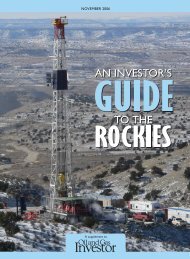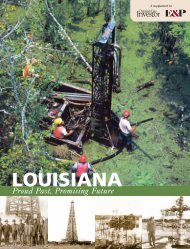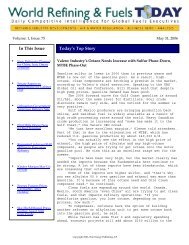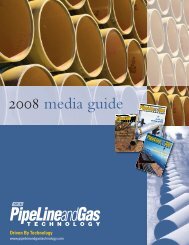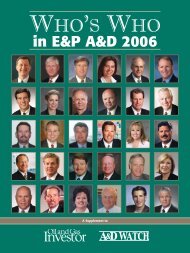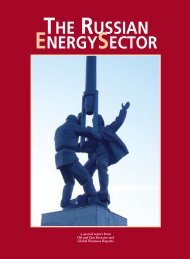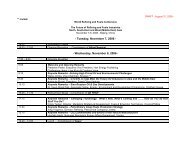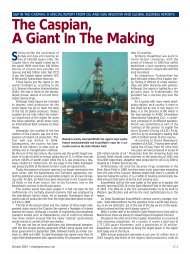ASTM: Gasoline Today and Tomorrow – An Executive Report
ASTM: Gasoline Today and Tomorrow – An Executive Report
ASTM: Gasoline Today and Tomorrow – An Executive Report
Create successful ePaper yourself
Turn your PDF publications into a flip-book with our unique Google optimized e-Paper software.
Octane Week | <strong>ASTM</strong>: <strong>Gasoline</strong> <strong>Today</strong> <strong>and</strong> <strong>Tomorrow</strong> - <strong>An</strong> <strong>Executive</strong> <strong>Report</strong><br />
Industry Awaits News of <strong>ASTM</strong>ʼs Sulfur Test Method Round Robin<br />
This story appeared on June 19, 2006.<br />
Stakeholders in the fuel industry have suspected for<br />
some time that D2622, <strong>ASTM</strong>ʼs St<strong>and</strong>ard Test Method for<br />
Sulfur in Petroleum Products by Wavelength Dispersive<br />
X-ray Fluorescence Spectrometry (WDXRF), could<br />
perform better than its published precision statement<br />
indicates.<br />
With fuel sulfur levels plunging this year, it became<br />
imperative that D2622ʼs measurement capability<br />
be improved, <strong>and</strong> that a new precision statement be<br />
developed for one of the most widely used sulfur test<br />
methods going. That effort has been underway in earnest<br />
since the beginning of the year, <strong>and</strong> an update from the<br />
<strong>ASTM</strong> work group may be forthcoming at the <strong>ASTM</strong><br />
D02.A Subcommittee on <strong>Gasoline</strong> <strong>and</strong> Oxygenated<br />
Fuelsʼ June meeting in Toronto, Ontario, Canada.<br />
The sulfur test method review has been undertaken<br />
by the D02.03 Subcommittee on Elemental <strong>An</strong>alysis.<br />
Method D2622 is a critical compliance method for fuels<br />
certification, but it does not reflect the state-of-the-art<br />
WDXRF technology. A significant revision to the test<br />
method is needed to do that.<br />
Although there are other test methods for<br />
determining sulfur content of fuels, D2622 provides<br />
rapid <strong>and</strong> precise measurement of total sulfur in<br />
petroleum <strong>and</strong> petroleum products with a minimum of<br />
sample preparation. A typical analysis time is one to<br />
two minutes per sample.<br />
Knowledge of sulfur concentration is necessary for<br />
refining as well as for certifying compliance with federal<br />
<strong>and</strong> state fuel sulfur regulations. Sulfur regulations<br />
tightened June 1, when the U.S. EPAʼs 15 ppm sulfur<br />
limit for highway diesel took effect. The tightening of<br />
the diesel spec follows the implementation Jan. 1 of a<br />
30 ppm annual average sulfur cap under EPAʼs Tier 2<br />
gasoline rules.<br />
The pooled limit of quantitation for D2622 is in<br />
the range of 15-20 ppm sulfur, making the test nearly<br />
obsolete in the ultra-low sulfur environment taking<br />
shape in 2006.<br />
“Equipment vendors <strong>and</strong> users realized the test<br />
had to do better, <strong>and</strong> they believed that it could,” said a<br />
source familiar with the research.<br />
A Task Group reviewing D2622 planned a roundrobin<br />
test program. A status update may be available in<br />
time for the D02.A meeting in Toronto June 26-27. For<br />
more information about the meeting, log on to www.<br />
astm.org.<br />
<strong>ASTM</strong> Members Consider 1-PPM Sulfate Spec for Ethanol<br />
This story appeared in July 2005.<br />
Pittsburgh, Pa. <strong>–</strong> <strong>ASTM</strong> subcommittee members<br />
will be asked whether they favor establishing a sulfate<br />
specification for ethanol. The D-02 A subcommittee voted<br />
to poll members by ballot to determine whether they favor<br />
modifying D-4806, <strong>ASTM</strong>ʼs St<strong>and</strong>ard Specification for<br />
Denatured Fuel Ethanol, to include a 1-ppm sulfate limit.<br />
The vote to “ballot” the issue came just hours<br />
after presentations from oil, auto <strong>and</strong> ethanol industry<br />
representatives on the issue of fuel injector damage,<br />
which has been tied to high sulfate content gasoline.<br />
The problem first surfaced in 2003 with equipment<br />
failures at service stations in Minnesota, St. Louis, Mo.,<br />
Los <strong>An</strong>geles, Chicago <strong>and</strong> the Pacific Northwest.<br />
“We have seen widespread <strong>and</strong> prolonged<br />
service station filter plugging,” said Mitch Oliver of<br />
ConocoPhillips. Filters failed in a matter of days or weeks,<br />
rather than the months of useful life they ordinarily have.<br />
<strong>An</strong> investigation revealed sodium sulfate salts.<br />
There were no issues with conventional fuels<br />
or sulfuric acid alkylation by-products, Oliver said.<br />
Detergents were also ruled out as a source, although<br />
they play a role.<br />
“The common denominator was fuel ethanol,”<br />
he said, <strong>and</strong> the presence of sodium sulfate salt was<br />
confirmed by a Bar Chart Haze test.<br />
ConocoPhillips surveyed its ethanol suppliers in the<br />
affected regions. The company performed 300 analyses<br />
using ion chromatography (IC), which showed sodium<br />
sulfate content ranged from non-detectible levels to 23<br />
ppm in the worst sample. The average was 2-4 ppm.<br />
“Sulfates greater than 1 ppm cause severe problems<br />
on filter performance,” Oliver (continued on p11)<br />
10 February 2007



